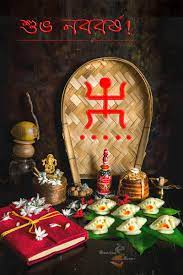|
BENGALI'S NEW YEAR
|
|
Pohela Boishakh (Bengali: পহেলা বৈশাখ)[n 1] is the first day of the Bengali calendar which is also the official calendar of Bangladesh. This festival is celebrated on 14 April in Bangladesh and 15 April in the Indian[2] states of West Bengal, Tripura, Jharkhand and Assam (Barak Valley) by Bengalis regardless of religious faith.
Celebration of Pohela Boishakh traces its roots to the traditions of Old Dhaka's Muslim community during Mughal rule, as well as the proclamation of tax collection reforms of Akbar.
The festival is celebrated with processions, fairs and family time. The traditional greeting for Bengalis in the new year is শুভ নববর্ষ "Shubho Noboborsho" which is literally "Happy New Year". The festive Mangal Shobhajatra is organised in Bangladesh. In 2016, the UNESCO declared this festivity organised by the Faculty of Fine Arts, University of Dhaka as a cultural heritage of humanity.
In Bengali, the word Pohela (or Pahela Bengali: পহেলা), alternatively Poila (Bengali: পয়লা), means 'first' and Boishakh (or Baishak Bengali: বৈশাখ) is the first month of the Bengali calendar (Bengali: পহেলা বৈশাখ Pohela Boishakh, Pahela Boishakh, Pahale Baishak or Bengali: পয়লা বৈশাখ Poila Boishakh).
Bengali New Year is referred to in Bengali as Nobo Borsho (Bengali: নববর্ষ), where 'Nobo' means new and 'Borsho' means year.
|
 |
Pohela Boisakh has been the traditional New Year festival in the state, with the new year referred to as the Noboborsho.[23] The festival falls on 14 or 15 April, as West Bengal follows its traditional Bengali calendar, which adjusts for solar cycle differently than the one used in Bangladesh where the festival falls on 14 April.
Notable events of West Bengal include the early morning cultural processions called Prabhat Pheri. These processions see dance troupes and children dressed up with floats, displaying their performance arts to songs of Rabindranath Tagore.
On this occasion, males are seen wearing red or white Kurta with traditional designs on them, imprinted or embroidered. Women and young ladies wear red and white saree with blouses and put on flower crowns on their heads. Girls also dress in salwar kameez. They are seen wearing traditional ornaments and accessories along with their dresses. It is thought that it is because the traditional ledgers used in Haal Khata had a red cover with white pages.
Haal Khata is a festival celebrated on the occasion of Pohela Boishakh in order to complete all the account reckonings of the last year and open a new ledger. It is observed by the Bengali businessmen, shopkeepers and traders. It signifies that every year starts with a new beginning.
|
 |
 |
 |
 |
|
HOME
|




